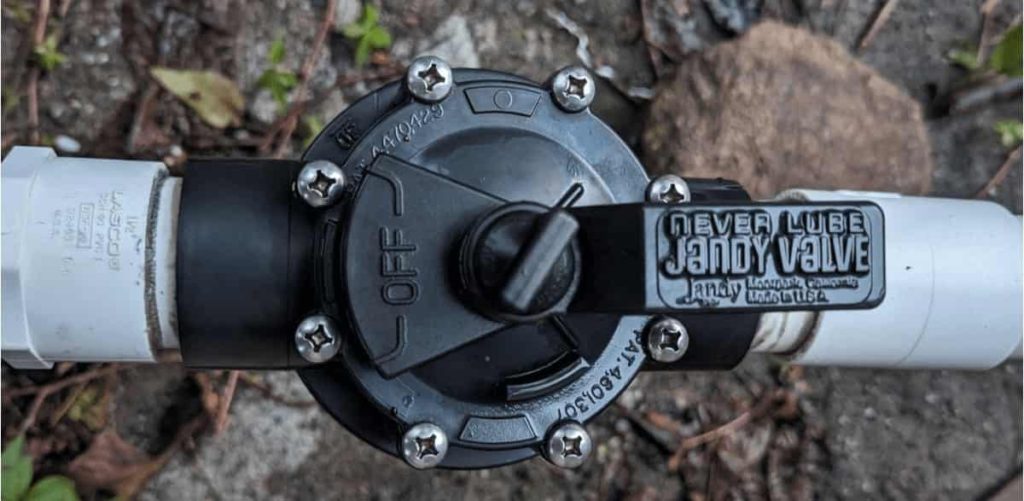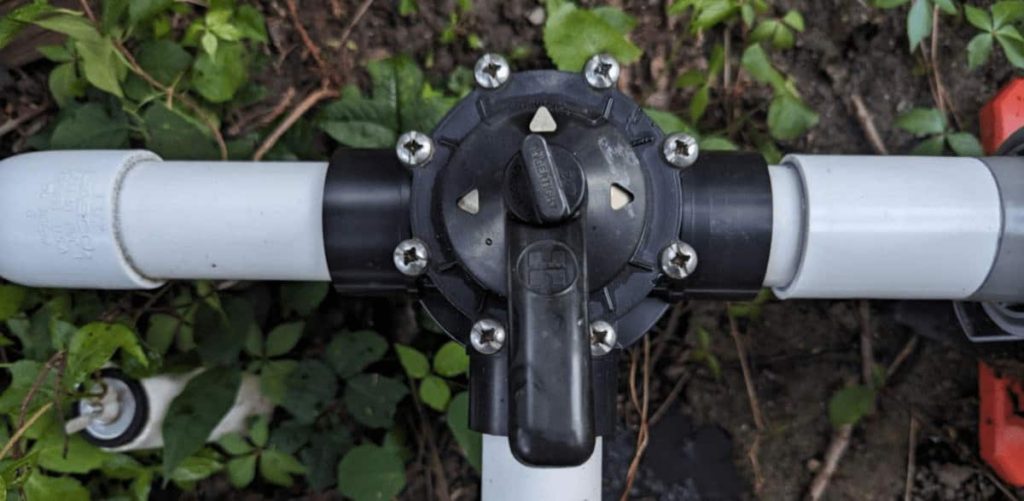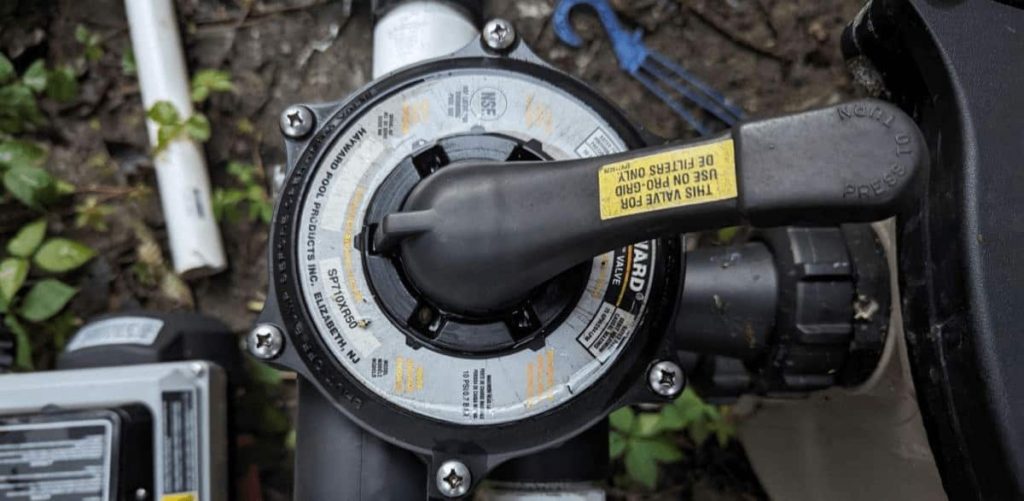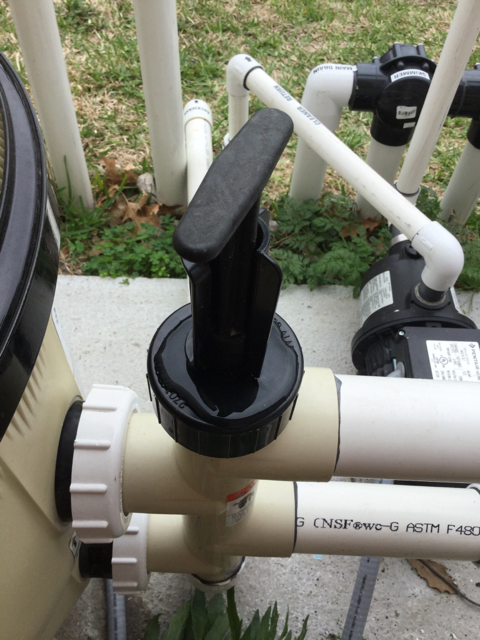Pool valves are unsung heroes of a pool’s plumbing. Each part of the pool uses valves to ensure water goes to the necessary place or doesn’t flow back into other pieces of equipment.
Surprisingly, there are many different types of pool valves, each with its benefits and use cases.
What are Pool Valves
Simply put, pool valves control water flow through the pool’s plumbing. They allow water to flow into or away from the pool and divert water from one area of a pool to another.

Pool valves make sure all elements are flowing in the right direction. Depending on the type of pool valve installed, they are either there to direct or prevent water flow.
The Different Types of Pool Valves
Ball Valve
One of the more simplistic valves for the pool, a ball valve, will limit the flow of water in one direction and can prevent water flow completely if necessary.
When the handle is turned, a ball is rotated inside the valve’s body which blocks the flow.
When to use ball valves: Ball valves are used where you need to stop the flow of water completely, but not so much for an adjusted control of the water flow. Ball valves can be installed on both the suction and return sides of the piping.
Butterfly Valve
Butterfly valves work pretty much the same as a ball valve. They consist of a disk that spins to regulate the flow of water.
When the valve is closed, the disk is turned to block off the pipe completely. When the valve is open, it allows an almost unrestricted passage of the fluid. The valve can also be turned halfway to slow the flow of water.
When to use a Butterfly Valve: Butterfly valves can be used in any part of your pool system where you need to adjust the flow rate. They are much more common in commercial and public pools but can still be used for your residential pool.
Diverter Valve
Diverter valves are one of the more common valves in a pool system, and there is a high probability that your inground pool has one.
They are primarily used to direct water flow to different parts of the pool system. Diverter valves have either two or three openings that water can enter from:
- Two-way valves act like butterfly or ball valves but are much more sturdy and reliable. They can let water fully flow, totally block water flow, or allow partial water flow. These valves have handles that rotate 90 degrees.
- Three-way valves have a 180-degree handle that can regulate two “out” ports and one “in” port (water flows through one pipe and then splits into two separate pipes). These valves give you the flexibility to allow full water flow or completely shut off one or both ports.

One distinct advantage of diverter pool valves is their ability to airlock a pipe which is especially useful when closing the pool for the fall and winter.
For example, if you have a three-way valve connected to two skimmers, you can blow one line out while the other is closed, blow the other line, and then completely close it off.
When to use a Diverter Valve: They can be used on the pool’s suction and return lines. Use them to regulate water flow to different parts of the pool, whether skimmers, return jets, water features, or the main drain.
Check Valve
Check valves allow water to flow in one direction only and automatically prevent backflow by closing when the water tries to go the other way. When the pump is turned off, there are many instances where we would not want water to flow back into the equipment.
One of the common uses of check valves is for pools that use a chlorinator or saltwater generator, usually the last piece of equipment in the plumbing system before the water goes back into the pool. Since they generate more concentrated amounts of chlorine, if water flows back into the heater or pool pump, it can cause permanent damage.
The check valve is installed between the chlorinator and heater or pump, so water can’t go backward if the pump is off for whatever reason.
When to use a Check Valve: These valves are most commonly installed between a chlorinator and heater or pump. However, they can also be used for any reason water should not flow back into the plumbing, like for a connected spa or water feature using its water source.
Valve Actuators
Valve actuators are devices that can automatically turn valves on or off. Yes, pool automation has also come to the valves themselves!
They are mounted on diverter valves and hardwired directly into your pool’s control system. With a simple push of a button, either a controller or even an app depending on what type, the diverter valve can open or close the water flow.
When to use Valve Actuators: Valve actuators are usually another piece of an automated pool. If you are already deep into automation, actuators will enhance the overall level.
Multiport Valves
A multiport valve (MPV for short) is used on your pool filter, allowing multiple flow options through a single port. These valves are only used for sand and DE filters, not cartridge filters.

Depending on what you are doing, a multiport valve can direct water in many different directions. These valves have variations of the following settings:
- Filter: This position is what would be a “normal” operation. Water goes through the suction lines into the pump, through the filter, and pushed back into the pull from the return lines. The valve will be set to filter the majority of the time.
- Waste: The waste position will send water directly from the pump and into a waste line, typically the backwash line or hose. Waste is most commonly used for lowering the water level or vacuuming fine sediment in the pool that the filter can’t catch. Anything we want to remove without passing through the filter is set to the waste setting.
- Backwash: The backwash setting is used to clean both sand and DE filters. While water still flows into the pump and through the filter, the flow is reversed. Typically, filters have an entrance point and an exit point. In a backwash, water enters through the exit and exits through the entrance (whew!). It then goes to the backwash line or hose. Backwashing is typically done when the filter’s pressure gauge reads 8 to 10 PSI above its “normal” setting.
- Rinse: The Rinse position is usually done in tandem with backwashing. It works the same as the backwash position except water enters and exits the filter normally, and then is sent to the backwash line. After backwashing, a rinse will flush the remaining particles of floating sand or DE that may be in the filter.
- Recirculate: The recirculate position completely bypasses the filter. When the water comes through the suction line and into the pump, it goes right to the return side and back to the pool. Recirculate is mainly used when the filter is broken or unable to be used. This way, water can still flow and circulate the pool until the filter can be used again.
- Closed: This is most likely the least used setting out of the bunch. Closed will not let water enter the valve in any location. It can act like the filter’s check valve so water doesn’t flow back into the filter if it is below the water level.
- Winter: The winter setting is aptly named to use during pool closing and the off-season. For almost all MPVs, the winter setting isn’t an actual setting but rather in between two other positions. It essentially “lifts” the valve’s ports about halfway, allowing water that happens to be trapped inside freely expand into ice without damaging the valve itself.
When to use Multiport Valves: Multiport valves are typically used on sand and DE filters.
Slide Valve
A slide valve is another pool filter valve, but it is a much simpler version of a multiport valve. These have two settings: filter and backwash.
Not all filters require the multiple positions an MPV will provide. Slides valves give you the two most important settings.
When to use a Slide Valve: Slide valves are used when simplicity is more important than having a lot of different settings. Since they either filter or backwash, slide valves are used on sand and DE filters, not cartridge.
Pool Valve Maintenance and Leak Checks
As valves are constantly “working”, it’s inevitable that they break down over time. Regular checks and maintenance is important to ensure the valves are working correctly.
One of the more common issues with valves is that they can leak. Leaks should be promptly addressed to prevent further damage to other pool equipment and minimize the loss of pool water.

It’s always good to do a quick visual check around valves and see if you notice anything out of the ordinary. In particular, look for wet spots or dampness around the valves. This is a sure sign of a leak and some may be more obvious with visible water streaming or dripping down.
Routine checks of the valve’s O-rings, turning mechanism, and overall body for leaks and cracks will ensure your valves last as long as possible
How to Repair or Replace a Valve
If you do happen to notice an issue with one of your valves, you can either repair or replace it depending on what is wrong.
Repairing a valve will require you to buy replacement parts, taking the valve apart, and replacing the damaged piece. Most repair jobs and be DIY but if you are unsure, call a pool professional for help.
Here is a helpful video on repairing a diverter valve.
Replacing a pool valve involves several steps and requires basic tools, such as a tube cutter or saw, wrench, screwdriver, and plumber’s tape. Here’s a general process you can follow.
Most likely, the valve will need to be cut from the plumbing and replaced that way. As always, anything you are uncomfortable with doing yourself can be easily done by a professional.
Here’s a video of a diverter valve replacement.
Now you Know How “Valve-uable” These Are!
I am so sorry for that pun, but it is true! Valves truly are a valuable piece of the over pool system.
A large majority of the time they do not need to be touched or turned, but it is always good to understand how they work and what happens when they do turn.
Now, back to your scheduled programming, err, swimming!
